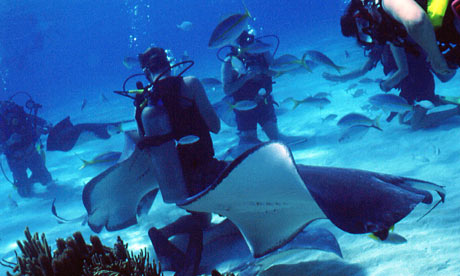- guardian.co.uk, Friday 29 May 2009 15.00 BST

The Grand Cayman sandbank, dubbed Stingray City, regularly attracts up to 2,500 visitors at a time. Photograph: Cayman Islands Department of Tourism
It features regularly on lists of things people want to do before they die, but swimming with stingray may not be the life-enhancing experience expected – at least not for the animals.
A new study has revealed that stingray at a tourist hotspot in the Cayman Islands are suffering because of all the human attention. The Grand Cayman sandbank, dubbed Stingray City, is regularly swamped with up to 2,500 visitors at a time, most of whom have paid handsomely for the chance to feed, stroke and swim with the creatures.
The study highlights the risks to animals posed by the growing "wildlife tourism" industry. Experts say wild populations of creatures such as dolphins, penguins and sharks are also affected by increased contact with curious people.
The study was one of the first to investigate direct effects on the physiology of animals involved in such tourism. Blood tests showed that the stingrays at Stingray City had weaker immune systems and were in poorer health than animals not disturbed by tourists, perhaps making them more vulnerable to disease and storms.
The experts warn that the "long-term health and survival of tourist stingrays have a significant probability of being affected" and they call for tighter regulation of the industry. Similar crowded tourist sites across the world will be doing similar damage to stingray, they say.
Christina Semeniuk, an ecologist at Simon Fraser University in Canada, who led the research, said: "Our study is the first to definitively show negative physiological impacts that indicate long-term costs to the animals' health."
She added: "The implications of these findings will not only affect the wildlife. Reduced stingray numbers, or injured, unhealthy-looking stingrays can cause the visitor site to become less attractive and may cause a decline in tourist numbers and have an economic impact."
The stingray at the site are regularly injured by boats, the scientists found, while the crowded conditions encourage parasites. The creatures have also come to rely on hand-fed squid, which stingray do not usually eat. "These impacts can have long-term health effects, in terms of reduced longevity and reduced reproductive effort," Semeniuk said. The results will be published in the journal Biological Conservation.
Other studies have looked at the impact of wildlife tourism on grizzly bears, penguins, dolphins, sharks and lizards. "The majority of these studies have looked at changes in the animals' behaviours or their stress responses," Semeniuk said. "Each has suggested that wildlife tourism should be both continually researched and managed."
Vincent Janik of the Sea Mammal Research Unit at St Andrews University said: "It's an important issue, and there doesn't need to be physical contact. Even just watching animals can sometimes bring problems." Studies have shown that dolphins regularly targeted by tourist boats are more likely to be injured and to abandon their young, he said.
Swimming with wild dolphins is banned in many places because of the likely impact on the animals.
Courtney Vail of the Whale and Dolphin Conservation Society said the treatment of captive dolphins was to blame for the way people treated the animals they encountered in the wild. "You get people trying to ride on their backs and holding on to the dorsal fin. They are trying to recreate the Sea World experience with wild dolphins."
Janik said efforts to control wildlife tourism, such as the stingray experience in the Caymans, need to be handled carefully. "If the tourists aren't there then these animals could just be hunted or eaten. The best way is to educate the operators and the customers." Many of the negative effects of wildlife tourism are likely to be restricted to local populations of animals, he said.
Semeniuk said new legislation in the Cayman Islands has recently been introduced to address the impact of tourists on wildlife. New Wildlife Interaction Zones, including the North Sound of Grand Cayman where Stingray City is located, forbid people taking marine life out of the water. Feeding wildlife will also be more strictly regulated.
But not all of the recorded impacts of wildlife tourism on animals are bad. While most wild creatures react as if the humans are predators, some see tourists as beneficial, either because they reduce the risks of predation by others, or because they supply food. This can allow the animals to dedicate more valuable energy supplies to rest and reproduction.
Disturbia
Dolphins: Creatures in Australia targetted by tourists are more likely to abandon their young
Killer whales: Whale watching in Canadian waters is shown to reduce animal feeding time
Penguins: Even minimal human contact is shown to double the heart rate of New Zealand's yellow-eyed penguins
Apes: Mountain gorillas of Uganda, Rwanda and the Democratic Republic of the Congo are known to be susceptible to human diseases

No comments:
Post a Comment